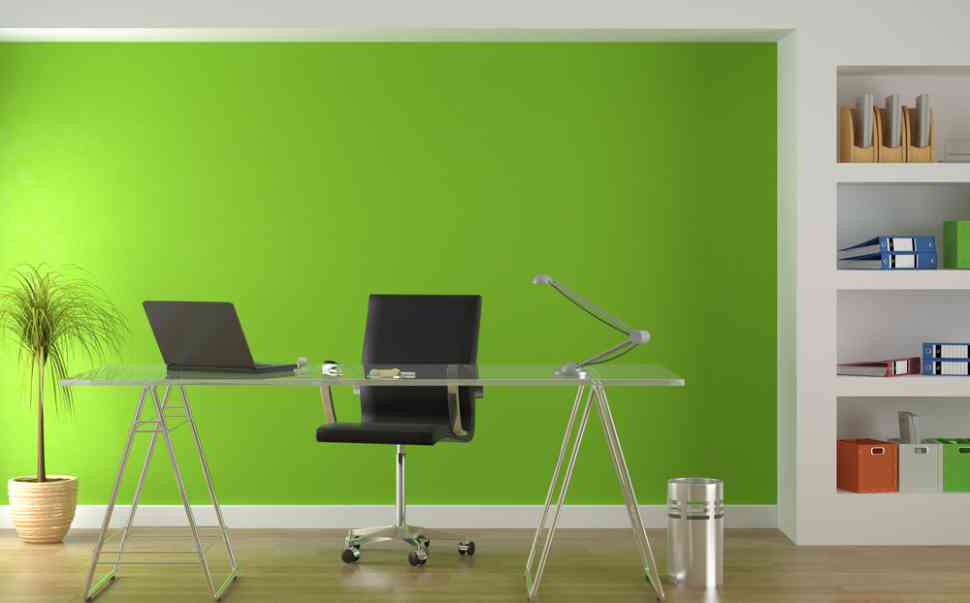Ideal Colors for the Workplace

Professional spaces, whether in our home or working environment, must increase productivity and creativity and promote comfort and positivity for maximum results. Design should encourage us to work and keep us focused and productive, so the color in the workplace must be chosen carefully.
Natural light, proper ventilation, pleasant temperature, but also the color of the room, furniture, and equipment are all crucial factors for more efficient work. We now know that each color impacts our psychology and mood differently. So, for our office, it would be beneficial to choose colors that promote productivity, energy, and concentration.
To choose the appropriate colors, it is advisable to think about the space size, what mood we want to enhance in the people who work there, and the color harmony for a smooth result. Of course, the proportions of colors and the placement of each in the space play an important role. We must consider what the location of the furniture will be, especially the office, and the function of the space in general. Depending on the color, we can promote different qualities of the employee’s character or ourselves.
We are all characterized by diversity, and the elements that each color brings out already exist in us. However, keeping them on the surface and not letting them be buried underneath a bunch of different personality characteristics is essential. Some ideal colors for the office, which can be used in soft intensity or not, depending on the desired result, are the following: brown, green, blue, purple, and yellow.
Especially if we work from home, we can use color in our workplace, with the most positive results for us. With a combination of colors depending on our character and needs, we will achieve maximum efficiency in our work. Let’s remember that we can use color for our benefit, even in small details, such as office accessories, but also in plants or flowers. Smaller items can be changed much more quickly, based on our needs.
The position of colors also plays a vital role in productivity. A strong hue on the wall we look at while we sit at the desk will have a different effect compared with another on the wall we have on our back while we work. The amount of color is also critical. Depending on our personality and the results we are looking for, we must come up with the quantity of color in the workplace.
The proportion is a completely personal choice. Some people can work better in an environment with a lot of colors around it, on walls, furniture, and decorations, because they give it energy and creativity. While someone else, with a need for more concentration, can work more effectively in a visually quieter environment with white walls and color present as decorative touches in details rather than large surfaces. Some suitable colors for colored accents in more simple spaces are: white, purple, pink, red, orange, and yellow.
Whatever strategy you decide to follow, remember that colors are catchy. Even though design and architecture are crucial, vivid color is the first thing a person’s eye will see. Regardless of how uneducated in terms of aesthetics an individual is, the colors will make a difference, so remember to pay attention and focus on the goals you want to achieve. Of course, in addition to the points mentioned, we can use colors wherever we want and wherever we like. The above is the first guide for those who need a little inspiration.
Have you read?
Rebranding for all the right reasons by Charlene Gervais.
3 Ways CEOs Can Create a More Resilient Workforce by Bjorn Reynolds.
The Number One Question Leaders Are Not Asking That Will Change the Game When They Do by Stef Ziev.
What Leadership Skills in the 21st Century Leaders Need by Prof. M.S. Rao, Ph.D.
CEO Spotlight: Bhaktraj Singh, CEO of Hazelton Group.
Bring the best of the CEOWORLD magazine's global journalism to audiences in the United States and around the world. - Add CEOWORLD magazine to your Google News feed.
Follow CEOWORLD magazine headlines on: Google News, LinkedIn, Twitter, and Facebook.
Copyright 2025 The CEOWORLD magazine. All rights reserved. This material (and any extract from it) must not be copied, redistributed or placed on any website, without CEOWORLD magazine' prior written consent. For media queries, please contact: info@ceoworld.biz








